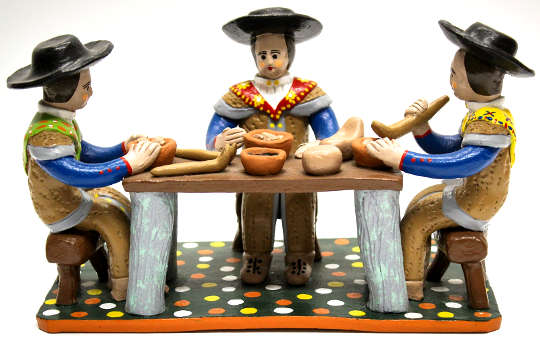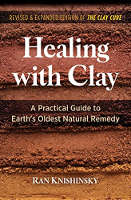
Image by INFOpaty
A man may esteem himself happy
when that which is his food is also his medicine.
-- Henry David Thoreau
There are many reasons why so many people of different ages, cultures, and races eat clay. Do these earth-eaters know something most people don’t? Yes, they do. Now you will know, too.
Why People Eat Clay
While everyone in the world eats earth in some way or another, it’s time to dish the dirt on the eight basic reasons I have found for why people eat clay. In fact, humans have been eating clay for a very long time. There is good evidence to suggest that we were chomping on it two million years ago.
-
Instinct
Get The Latest By Email
-
Medicinal uses
-
Detoxification
-
Mineral supplementation
-
Religious rites
-
Famine food
-
Use in pregnancy
-
A food delicacy
Clay eating has nothing to do with climate, geography, culture, race, or creed. It is found in the most developed countries, where people like you or me who live in the Western world consume it, and among developing populations throughout the globe. The habit does not belong to any particular group, so no one population can be clearly branded as clay-eaters or non-clay-eaters. In any one family, some persons will eat clay, while others will outright refuse. The habit is an individual one.
Instinct
Human beings have many inborn behaviors, or instincts. For instance, it is our very character to taste and test anything offered to us by nature; and eating clay, mud, or rocks is no more surprising than eating salt, herbs, chewing gum, tobacco, cows, or snails.
Throughout human history naturally occurring toxins have placed constraints on what types of plants people could consume. Clay eating provided the person with a certain degree of protection, allowing greater flexibility of choice in their diet. People did not possess a deep scientific understanding of why they ate clay or could pinpoint what exactly was the healthful effect. Talk to someone who eats clay and ask them why they do it, and you’d be apt to receive a shrug with a response like, “Not sure why I eat clay, but I do.”
Surprisingly, in an article published in The Quarterly Review of Biology, geophagists (people who eat clay or dirt) are said to be highly selective about the earth that they eat. In 237 of 243 cultural reports (98%), there was a preference for earth that was claylike or smooth rather than gritty and sandy. Intuition strikes again! It leads the earth-eater particularly toward clay versus the plain old dirt sitting in the school playground.
To help us to understand why instinct might play a role in the decision to eat dirt, we are led to this action by one of three reasons:
-
A response to hunger where clay has traditionally been used in times of famine and drought
-
Micronutrient deficiencies such as iron or calcium, which is particularly high in clay
-
Clay’s healthful protection against harm from toxins and pathogens
Medicinal Uses
Earth itself may be the world’s oldest medicine. Clay eating has apparently been a recommended medicine for thousands of years. Most of us have not heard about it since such recommendations have been practically swept under the rug in Western medicine. However, the practice of eating clay is ultimately rooted in its medicinal value and dates back long before medicine in the modern world came into being.
Many think of soil as lifeless dirt. On the contrary, it is teaming with a rich array of microbial life. Recently, National Institutes of Health (NIH)–funded researchers discovered a new class of antibiotics, called malacidins, by analyzing the DNA of the bacteria living in more than 2,000 soil samples, including many sent by citizen scientists living all across the United States. They established a website with a clever, easy-to-understand name, DrugsFromDirt, where they solicit soil samples from around the world to advance the discovery of therapeutic agents in dirt.
Throughout the world, the use of clay as medicine has found its way into several materia medica, which present a history of pharmacy from the body of collected knowledge about a substance used for healing. Clay has been noted in these texts when its use among populations has been well documented.
If we go back through our history books, we’ll see that the ancient Greek doctor Hippocrates, who is traditionally regarded as the father of modern medicine, reportedly was the first to write about geophagy. Galen, a great second-century CE Greek physician, later introduced eating Armenian earth into medical practice to cure all sorts of ills, including acne and hemorrhoids. In the Chinese pharmacopoeia, Ch’en Nan, born in the 1200s, was known for his successful healing treatments with clay and credited with curing diseases thought untreatable in his time. In India, Mahatma Gandhi recommended earth to overcome constipation.
Fast forward in time to the current day. A number of companies manufacture medicines with clay that are sold as over-the-counter and prescription antidiarrheal medicines. These include Diarrest, Di-gon II, Diatrol, Donnagel, Kaopek, K-Pek, Parepectolin, and Smecta. While many of these medicines are not available for sale in the United States, they are found on most major continents.
But that’s not all. Animals have also been prescribed clay for the treatment of intestinal distress and diarrhea. Dia-sorb and Endosorb, which both contain attapulgite clay, work by absorbing (binding) large numbers of bacteria and toxins and reducing the loss of water, thereby treating the condition. Clay is also an ingredient in some natural pet foods, added as an anti-caking agent with recognized health benefits for Fido.
There are thousands of ethnomedicine anecdotes to share from all over the world that provide insight into why clays are consumed.
Detoxification
The concept of edible clay for health purposes is becoming more popular as word about its detoxicant properties gets around. Clay may protect against toxins and pathogens by strengthening the mucosal layer by binding with mucin and/or stimulating mucin production, thereby reducing the permeability of the gut wall, as well as binding directly to toxins and pathogens, thereby rendering them unabsorbable by the gut.
In 1991, the American Journal of Clinical Nutrition published an article written by Timothy Johns and Martin Duquette on clay eating and detoxification titled “Detoxification and Mineral Supplementation as Functions of Geophagy.”
The CDC estimates that forty-eight million people in the United States experience foodborne illness each year. Here geophagic earth, especially if it’s clay rich, may be protective.
Mineral Supplementation
Clay provides an impressive assortment of minerals, including calcium, iron, magnesium, potassium, sulfur, manganese, and silica as well as trace elements—those appearing in very tiny amounts. Without the basic minerals, life cannot exist; without the trace minerals, major deficiencies will develop. The lack of either will make it impossible for the body to maintain good health.
Most people don’t realize the importance of mineral supplementation and underestimate their legitimacy and use. The body cannot manufacture its own minerals and is reliant on external sources to meet its need. Our requirement for minerals is as important as our need for air or water.
“The body can tolerate a deficiency of vitamins for a longer period of time than it can a deficiency of minerals. A slight change in the blood concentration of important minerals may rapidly endanger life,” Dr. F. P. Anita says in his book Clinical Dietetics and Nutrition. Furthermore, mineral deficiencies can exacerbate symptoms caused by vitamin deficiency.
Accordingly, clay has been used by many tribes and cultures in the treatment of anemia and other mineral deficiencies given its higher iron and calcium content.
Religious Rites
Many religions have made a positive connection between earth eating and spiritual and physical healing. Holy clay, the name for certain types of earth, is viewed as an extension of religious symbols through which transformation can take place. In Esquipulas, Guatemala, home of the St. Esquipulas shrine, 5.7 million holy clay tablets are produced annually! The tablet is seen as an extension of the power of the shrine and is believed to cure many illnesses, including ailments of the stomach, heart, eyes, and pelvis.
Interestingly, the Roman Catholic Church has indeed blessed medicinal clay tablets since the earliest days of Christianity, a millennium and a half before the statue of Esquipulas was carved.
Earth eating is also connected with religious belief among the Arabs and Muslims.
Famine Food
Grass, tree bark, wild herbs, weeds, and earth have always been primary food substitutes in famine times. With the threat of undernutrition, human beings will take whatever they can get their hands on—that is, anything to satisfy the stomach. Clay has been highly valued as a famine food because of its ability to calm hunger pangs and provide a source of mineral supplementation. After eating clay, one feels full and, strangely, satisfied.
During a famine in China, one group sold what were called stone-cakes, which consisted of wood pounded into dust and mixed with millet husks, then baked. Elsewhere, during the same famine, people made flour out of ground leaves, clay, and flower seeds. This was eaten as the daily diet until food could be found. In Europe, clay, referred to as “mountain meal,” was eaten in times of war and deprivation.
Different groups had many creative names for such food, calling it “mineral-flour,” “earth-rice,” or “stone-meal.” In 1911, more than a century ago, the French anthropologist F. Gaud reported that in periods of famine the Mana peoples of what is now the Democratic Republic of Congo “gather the earth of termites’ nests and consume it mixed with water and powdered tree-bark.”
There have been thousands of references in research reports documenting this similar type of activity where there is craving and eating of clays from anthills and termite mounds in not only humans but also animals.
Use in Pregnancy
Clay eating among pregnant women is common in many cultures around the globe. In some sub-Saharan African countries, a prevalence rate of up to 84 percent has been observed. Pregnant women cite nausea, vomiting, heartburn, and relief from stress as reasons for engaging in earth eating. Many others feel the instinctual need to eat clay, although they might not be able to fully articulate the reason for the desire.
In Malaysia, clay is eaten to help secure pregnancy by women who want to bear children. In New Guinea, pregnant women eat clay because they consider it good for the fetus. In Russia, one tribe considers clay placed on the tongue to be a good means of expediting birth and expelling the afterbirth. It is also taken to combat morning sickness.
People are quick to dismiss the earth cravings of pregnant women, since they often have strange cravings. In modern literature and most societies, eating earth has been largely depicted as a behavior limited to the deprived. Given the evidence from around the world, this practice doesn’t seem so strange after all—just misunderstood.
A Food Delicacy
Did you ever hear of eating chocolate-covered ants? As kids we used to joke about eating insects. As adults, we laugh about it when we see entrepreneurs selling cricket flour on the television show Shark Tank.
In India and Africa, however, this is no joking matter but rather a serious delicacy. People go to white ants’ nests and eat the soil with the ants included, sometimes adding honey to the preparation. They believe it’s good for strength and energy.
Along the north coast of New Guinea, the people eat earth as a type of sweetmeat. The taste varies from faintly sweet to one very much like chocolate. Another group nearby takes pains to roll and form clay into disks and tubes, cover the cakes with a solution of salt, smear them with coconut oil, and then roast and eat them.
While you and I would rather eat a piece of cake or a bag of chips as a snack, for many people around the world, clay with honey and sugar would be preferred. It sounds strange to us, but in cultures whose palates have not been overly exposed to artificial flavors and sweeteners, clay for dessert is a sure treat—and a healthy, low-calorie one at that!
You’re Already Eating Dirt
Although the idea of eating clay as a delicacy may seem foreign, most of us are already dirt-eaters in our daily lives in that we seek salt from the earth or oceans to add to our diet. We usually don’t think of salt as dirt, but salt is a deposit found in rocks, and clay and dirt are nothing more than weathered rocks.
Humans need about forty or fifty different nutrients to stay healthy, so sometimes we have to go outside the bounds of what’s considered food and add these items to our diet.
With regard to mineral ingestion from dirt, clay, or soil, we are supplementing our diets on a daily basis through other sources, too. When you eat an apple that hasn’t been fully washed, then there’s probably dust on it. On your vegetables like romaine lettuce, radishes, and potatoes, it’s the same thing. This also goes for those peanut shells that you might like to suck on at the ballpark because they just taste plain good and even salty!
High doses of calcium added to milk and orange juice can be viewed as acceptable forms of geophagy as well. Calcite is a mineral that is the main constituent of limestone and can be purchased in single-ingredient supplement bottles found in the health section of your local grocery store. But it is also found in widely recognized health products such as Rolaids and Tums, which are used to relieve indigestion and acid reflux. It’s surprising to learn that many of the foods we consume on a daily basis already fall into the category of geophagic eating.
As you can see, geophagy isn’t some strange, incomprehensible practice. We are all practitioners of geophagy nearly every day. And in some cases, that practice is essential to our health.
Copyright 2022. All Rights Reserved.
BOOK: Healing with Clay
Healing with Clay: A Practical Guide to Earth's Oldest Natural Remedy
by Ran Knishinsky
 In this revised and expanded edition of The Clay Cure, Ran Knishinsky explores the science and history behind eating clay, citing many clinical studies on the beneficial effects of clay consumption and revealing that clay eating is neither a crazy nor an aberrant behavior. He details how clay can be used as a protectant and detoxicant. He explains how clay is naturally absorbent and extremely gentle on the system and reveals how it’s safe to use, even during pregnancy. He also explores the newest scientific research around its detoxifying properties, antibacterial and antiviral effects, its potential use in obesity, and its role in the treatment of a handful of gastrointestinal conditions.
In this revised and expanded edition of The Clay Cure, Ran Knishinsky explores the science and history behind eating clay, citing many clinical studies on the beneficial effects of clay consumption and revealing that clay eating is neither a crazy nor an aberrant behavior. He details how clay can be used as a protectant and detoxicant. He explains how clay is naturally absorbent and extremely gentle on the system and reveals how it’s safe to use, even during pregnancy. He also explores the newest scientific research around its detoxifying properties, antibacterial and antiviral effects, its potential use in obesity, and its role in the treatment of a handful of gastrointestinal conditions.
For more info and/or to order this book, click here. Also available as an Audiobook and as a Kindle edition.
 About the Author
About the Author
Ran Knishinsky is a professional health researcher and writer and the founder of NutraConsulting, a consulting firm to the natural products industry. He is the author of Healing with Clay and Prickly Pear Cactus Medicine.
Visit the author's website at www.detoxdirt.com
More books by this Author.








